Warning letter template for poor performance
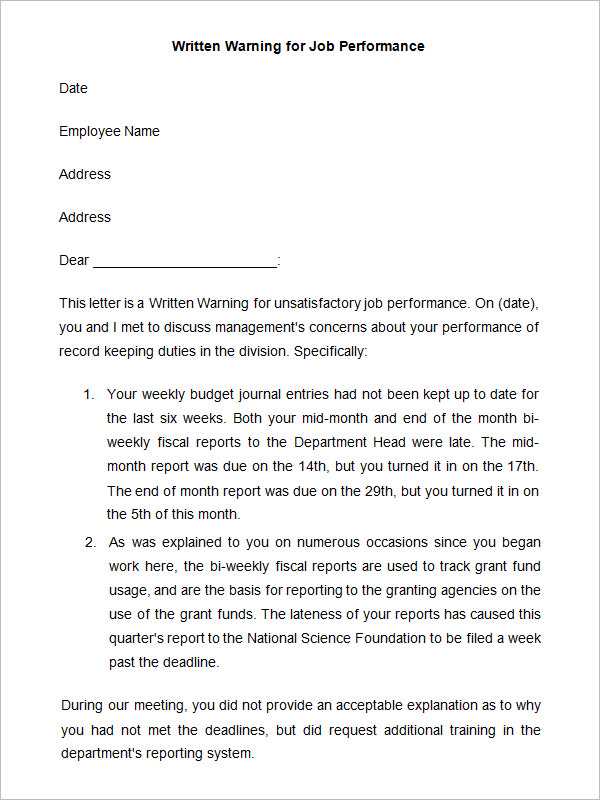
Address performance issues directly and professionally with a clear warning letter. A well-structured letter is key to making expectations known and providing a path to improvement. It’s important to be specific, focusing on the areas where performance has fallen short.
Start by clearly stating the purpose of the letter. Mention the specific performance issues and refer to any previous discussions or warnings if applicable. Set a tone that encourages positive change while emphasizing the importance of meeting company standards.
Outline expectations for improvement, providing a reasonable timeline for the employee to show progress. Ensure that the consequences of not improving are clearly communicated. Be constructive and offer assistance, such as training or guidance, to help the employee succeed.
Avoid emotional language, and focus on facts. Keep the letter professional and to the point, ensuring it serves as both a formal warning and a tool for future success.
Warning Letter Template for Poor Performance
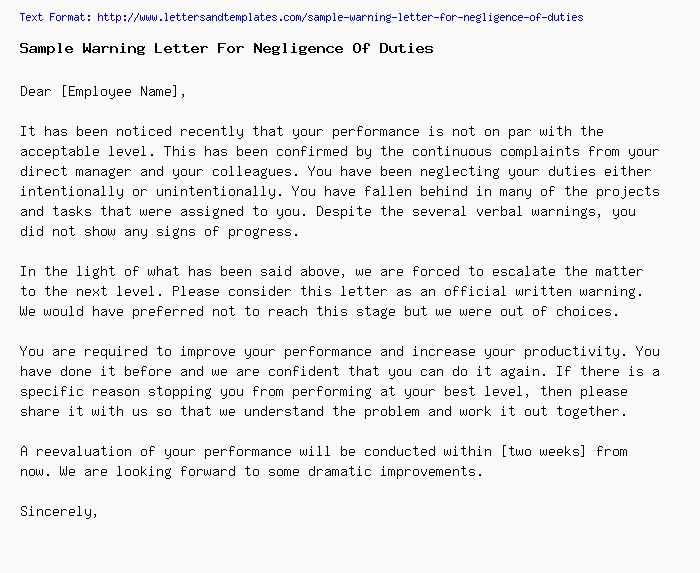
To address subpar performance, provide clear details and set expectations for improvement. Below is a simple template for crafting a warning letter:
Warning Letter Template
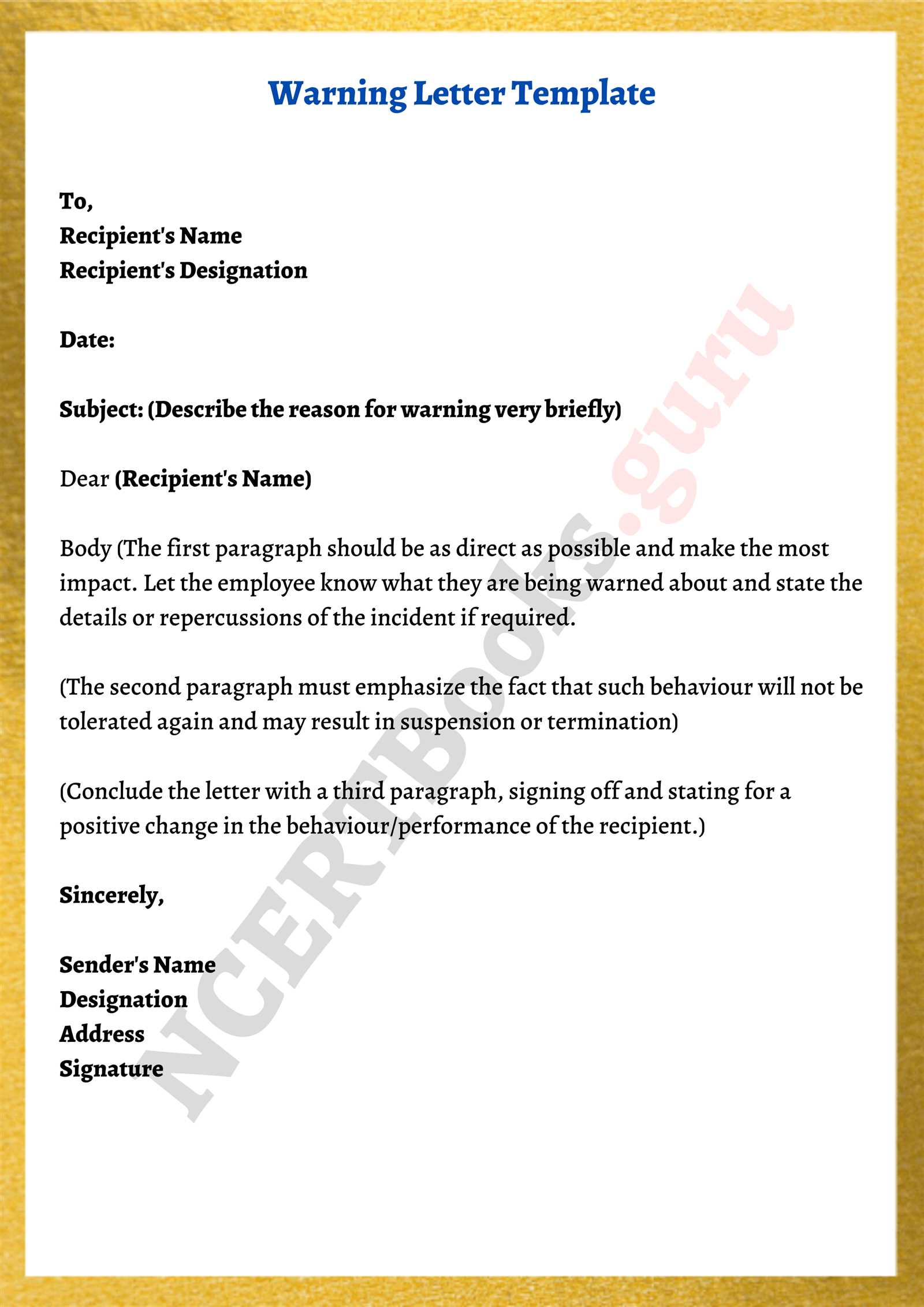
Dear [Employee’s Name],
This letter serves as a formal warning regarding your recent performance. Over the past [time frame], your performance has not met the standards expected for your role. Specifically, [mention specific issues such as missed deadlines, incomplete tasks, low-quality work, etc.].
We have discussed these concerns in previous meetings on [list dates if applicable]. Despite these conversations, there has been little to no improvement in your performance. We must emphasize that meeting performance expectations is critical to the success of the team and the organization.
We expect to see a marked improvement within the next [time frame]. Specifically, we are looking for [outline clear, measurable goals and expectations]. Failure to improve may result in further disciplinary action, up to and including termination of employment.
Please take this matter seriously and let us know if you need any assistance or clarification. We are here to support your success, but it is ultimately your responsibility to demonstrate progress moving forward.
Sincerely,
[Your Name]
[Your Title]
[Company Name]
Setting the Tone: How to Begin the Letter
Begin the letter by addressing the recipient with respect, making it clear that the purpose is to address performance issues constructively. Keep the tone professional, but also acknowledge the positive aspects of their work. This balance ensures the message is not overly negative from the start, fostering a more open response.
Start with a clear statement that outlines the reason for writing the letter. For example, “I am writing to address concerns regarding your recent performance.” This immediately sets the context while avoiding unnecessary criticism. From here, briefly mention specific areas that need improvement, avoiding any language that could seem personal or disparaging.
| Effective Phrases to Start the Letter | Avoid These Phrases |
|---|---|
| “I would like to discuss some areas where performance needs improvement.” | “You have been underperforming in several areas.” |
| “There are a few aspects of your work that require attention.” | “Your work has not been up to standard lately.” |
| “Let’s review the performance expectations and how we can work together to meet them.” | “Your performance is not meeting expectations, and we need to address it immediately.” |
By setting a cooperative and solutions-focused tone right from the start, you make it easier for the recipient to accept the feedback and engage in meaningful improvement.
Addressing Specific Performance Issues
Focus on identifying the exact areas where performance is lacking. Start by gathering concrete examples of missed deadlines, errors, or lack of initiative. Clear, specific feedback will provide a clear path for improvement.
Consider breaking down larger tasks into smaller, more manageable segments. This helps ensure that the individual can focus on achievable goals without feeling overwhelmed. Regular check-ins will keep progress on track and allow for timely adjustments if needed.
- Provide data-driven examples: For instance, “In the last two weeks, project X was delayed by 3 days due to incomplete reports.” This helps in understanding the exact performance gap.
- Offer guidance on how to improve: Suggest specific tools, resources, or training that could help close the gap in skills or knowledge.
- Set clear expectations moving forward: Specify the standard of work expected, such as “Timely submission of reports every Friday before 3 PM.” This creates a measurable goal for improvement.
Encourage open communication. Ask for feedback from the individual on potential obstacles they may be facing. Address these challenges together to ensure they have the support needed to improve.
- Provide resources: If technical skills are a factor, suggest relevant training programs. If time management is an issue, offer suggestions like using scheduling tools or prioritization techniques.
- Set clear and achievable milestones to monitor progress: “Let’s aim for 90% on-time report submission for the next two weeks.” This creates a tangible goal to work toward.
Offering Clear Expectations and Deadlines
Specify measurable goals and set realistic deadlines for improvement. Clearly outline the tasks and expectations in the warning letter. Be specific about the standards required, including how and when performance will be assessed. Include dates for progress checks and completion, so the employee knows exactly what is expected and when. This approach reduces confusion and helps the employee understand the urgency and focus needed to meet the performance requirements.
Set clear timelines for each task or objective, and offer a reasonable window for correction. Ensure the deadlines are achievable but still challenging enough to encourage improvement. By providing structured, time-bound expectations, you create accountability and give the employee a clear path forward to demonstrate their commitment to the job.
Explaining Consequences of Continued Poor Performance
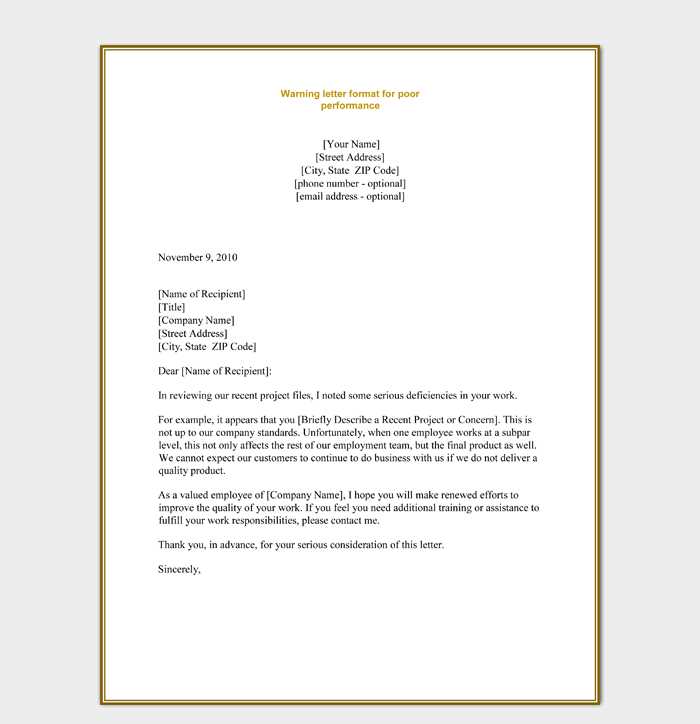
If performance does not improve, it can result in a range of consequences, including decreased team morale and a potential loss of trust from colleagues and superiors. Consistently falling short of expectations may limit opportunities for growth or advancement within the company. This can also negatively impact job security, as continued underperformance may lead to more formal actions, including probation or even termination.
Impact on Team Dynamics
When one team member consistently underperforms, it can create a heavier workload for others, leading to frustration and burnout. This can harm overall team productivity, making it difficult to maintain positive relationships and a collaborative work environment. It’s essential to address issues early to prevent these negative effects from escalating.
Professional Reputation
Ongoing poor performance may tarnish an individual’s reputation within the organization. Colleagues and management may begin to question the reliability and capability of the individual, affecting future opportunities for new projects, promotions, or lateral moves within the company. Maintaining a consistent level of performance is crucial for sustaining a positive professional image.
Providing Support and Opportunities for Improvement
Offer clear feedback and guidance to help the employee understand specific areas for improvement. Set realistic and measurable goals that will allow them to track their progress. Ensure they have access to the necessary resources, such as training programs or tools, to develop the required skills.
Regular Check-ins
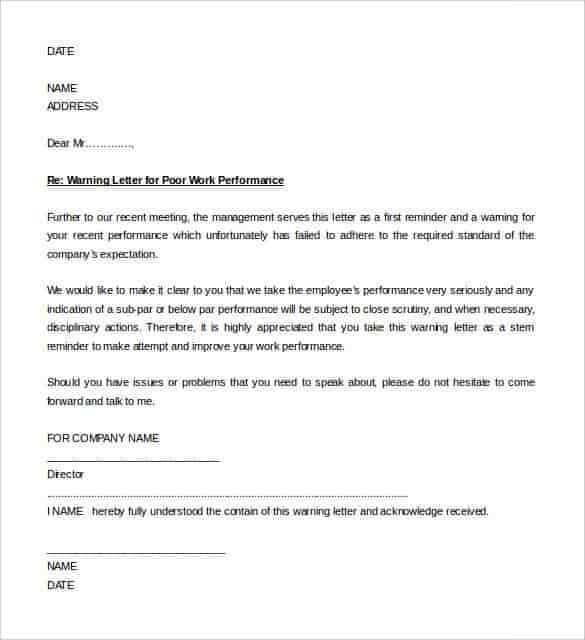
Establish regular meetings to assess progress and discuss any challenges. These sessions should provide a chance to offer constructive feedback and adjust the support plan if needed. Be sure to acknowledge improvements, even if they are small, to keep the employee motivated.
Clear Action Plan
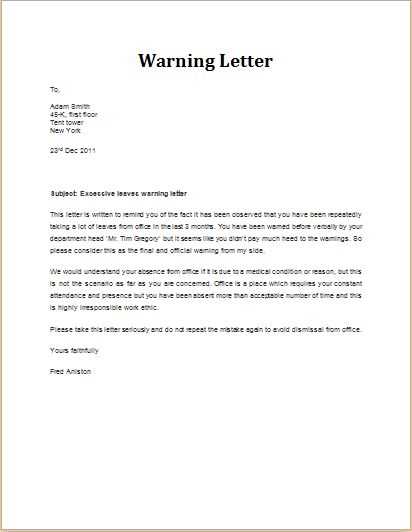
Help the employee create a structured action plan with deadlines and clear steps. This plan should include specific tasks that directly address the performance issues. Ensure they understand how to prioritize these tasks and feel confident in completing them. Offer guidance on how to approach tasks and where to focus attention for maximum improvement.
Concluding with a Professional and Constructive Approach
End the letter by focusing on clear expectations and next steps. Reiterate your confidence in the employee’s ability to improve, offering guidance and support as needed. Ensure the tone remains encouraging while also emphasizing the need for immediate action. Mention any follow-up meetings or progress reviews to monitor improvement. Reinforce your commitment to helping them succeed, but make it clear that continued poor performance will result in further consequences. This maintains professionalism while ensuring the message is constructive and forward-focused.
Close the letter with an invitation for the employee to discuss any concerns or challenges they may face. This shows you are open to dialogue and willing to collaborate in finding solutions. Ending with a positive and proactive tone will help the employee feel motivated to take the necessary steps to improve.